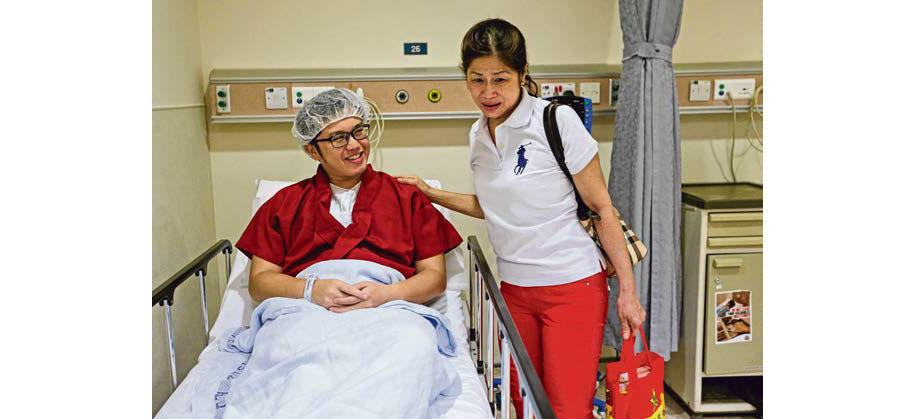The Straits Times (22 March 2018) - Once the brain is exposed, a little cerebrospinal fluid – the colourless liquid which surrounds the brain – is collected for research.
The tumour will also be deposited in the NNI’s brain tumour bank, which has amassed over 130 samples in the last decade.
The idea is to study the genetic make-up of the tumour, so that doctors will one day be able to tailor specific treatments for different patients, based on the tumour’s genetic signature.
“Zhi Long, are you awake now?” asks Prof See, head of anaesthesiology, intensive care and pain medicine at Tan Tock Seng Hospital.
“We’re going to start very soon, are you comfortable?”

Mr Oh Zhi Long, 32, putting on a brave front for his mother, Madam Seng Kiah Eng, 57, before getting wheeled into the operating theatre for the awake brain surgery.
The patient nods slightly.
Another hour has gone by.
The brain, home to 80 to 100 billion neurons, does not have any pain receptors and cannot feel anything. So it is the only major organ which can be operated on while the patient is awake.
As Prof Ng delves into the tumourous tissue, which is an unhealthy yellowish white compared with white healthy tissue, Prof See asks him to make a fist and moves forward with an iPad.
“Can you see without your glasses?” asks Prof See.
“I’ll try,” Mr Oh replies drowsily.
He is asked to name common images on the iPad, ranging from a car to a dolphin to roti prata.
“Can I see what’s in my head also?” Mr Oh asks, to which Prof Ng responds: “Later we’ll show you.”
Mr Oh has a few more questions – “Somehow my legs feel numb now, is it due to the brain?” (“No, it’s probably just the local pressure.”); “Is the tumour cutting into my vocal area?” (“No, the vocal area is behind it, so we’ll have to ask you some more questions later.”) “Okay, just cut more lah,” Mr Oh responds.
The naming test goes on as Prof Ng delves deeper into the brain to excise the tumour, and about four hours after Mr Oh is first wheeled into the operating theatre, the growth is removed.
Then comes the process of sewing back the dura and screwing the skull shut with titanium plates, and finally stitching up the scalp which had earlier been peeled back like the skin of a fruit.
Prof Ng tells him: “You did very well,” and his patient squeezes his hand one more time. Mr Oh is even able to move himself onto the hospital bed that will be wheeled into the recovery ward.
When he wakes up, he may remember very little of the entire procedure.
But he tells ST later: “I was joking but I felt a bit terrified. For my first surgery, it was quite a major one.” Primary brain cancers are rare, afflicting about 25 to 30 in every 100,000 people, said Prof Ng.
But if not treated, they can be extremely disabling and life-threatening because they grow rapidly and invade surrounding brain tissue.
In Mr Oh’s case, it was in the left frontal lobe, the part of the brain which has a lot of “reserves”, and is able to cope with significant damage with minimal or no deficit.
To make sure the cancer was eradicated, he also had to go through 30 sessions of radiotherapy, as well as eight months of chemotherapy.
After all that, his prognosis is good. Said Prof Ng: “As the tumour is largely benign, we hope that the aggressive treatment will lead to a cure.”
Mr Oh, who stayed active even when undergoing treatment, went back to work in July with a new zest for life. He exercises regularly and is determined to keep himself even fitter than he was before the operation. He also plays basketball and tries to eat healthily.
“I’m lucky that everything came together,” he said.